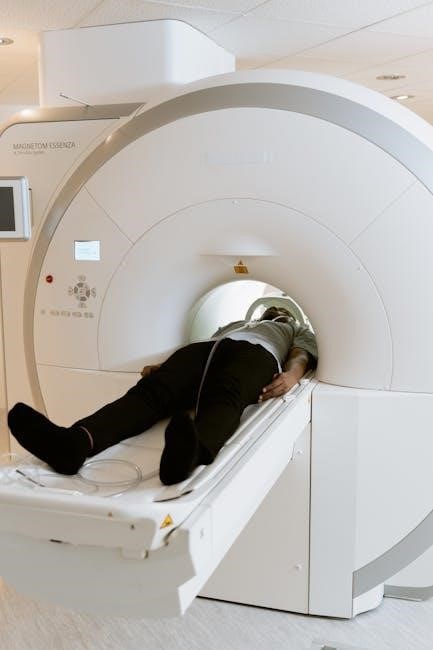Postural assessment is a critical evaluation of body alignment and balance, essential for identifying musculoskeletal disorders and improving overall well-being. It involves analyzing posture to detect abnormalities, prevent injuries, and enhance mobility, ensuring proper musculoskeletal function and stability.
Importance of Postural Assessment
Postural assessment plays a vital role in identifying musculoskeletal disorders and preventing injuries. It helps practitioners understand how body alignment affects movement and stability, enabling early detection of imbalances that may lead to chronic pain or dysfunction.

By evaluating posture, healthcare professionals can design personalized treatment plans to address specific needs, improving patient outcomes and enhancing quality of life. Regular assessments also promote proactive care, reducing the risk of long-term damage from poor posture.
In clinical settings, postural assessment is crucial for diagnosing conditions like spinal misalignment or balance disorders. It also aids in monitoring progress during rehabilitation, ensuring interventions are effective and tailored to the individual.
Moreover, postural evaluation is essential in occupational health, helping prevent work-related musculoskeletal injuries. By addressing ergonomic and postural issues, employers can create safer workplaces and reduce absenteeism due to musculoskeletal disorders.
Methods and Tools for Postural Assessment

Common methods include the Postural Assessment Scale for Stroke Patients (PASS) and the Balance Evaluation Systems Test (BEST). Tools like plumb line analysis, observational checklists, and sensor-based systems are also used to evaluate alignment and stability effectively.
Postural Assessment Scale for Stroke Patients (PASS)
The Postural Assessment Scale for Stroke Patients (PASS) is a widely used tool for evaluating postural control in stroke survivors. It consists of 13 items that assess a patient’s ability to maintain posture and perform voluntary movements. Each item is scored on a scale, with higher scores indicating better postural control. ThePASS focuses on key areas such as sitting, standing, and transitional movements, making it a comprehensive assessment tool. It is particularly useful for identifying postural deficits and monitoring progress during rehabilitation. The scale is administered by trained professionals who provide specific instructions for each task and record the patient’s performance. By using the PASS, clinicians can develop targeted interventions to improve balance, reduce fall risk, and enhance overall functional abilities in stroke patients. Its simplicity and effectiveness make it a valuable resource in neurorehabilitation settings.
Balance Evaluation Systems Test (BEST)
The Balance Evaluation Systems Test (BEST) is a comprehensive assessment tool designed to evaluate postural control and balance abilities. It is widely used in clinical settings to identify impairments in balance and to guide rehabilitation strategies. The BEST assesses various aspects of postural control, including sensory, motor, and cognitive contributions to balance. It consists of 36 items divided into six sections, each targeting different components of balance, such as sitting, standing, and transitional movements. The test is particularly useful for patients with neurological or vestibular disorders, as it provides detailed insights into their balance deficits. By identifying specific areas of weakness, clinicians can develop personalized treatment plans to improve stability, reduce fall risk, and enhance functional independence. The BEST is valued for its ability to offer a more nuanced understanding of balance impairments compared to other assessment tools, making it a valuable resource in rehabilitation practices.

Conducting a Postural Assessment
Conducting a postural assessment involves preparing the environment, positioning the patient, and systematically evaluating alignment, movement, and balance. Observations are made from multiple angles, and tools like plumb lines or sensors may be used to document findings accurately.

Preparation for Assessment
Preparation for a postural assessment is crucial to ensure accuracy and reliability. Begin by creating a quiet, private, and well-lit environment to minimize distractions. Ensure the client wears minimal, non-restrictive clothing to allow clear observation of body alignment. A plumb line, measuring tape, or digital sensors may be used to evaluate posture objectively. The client should stand or sit in their natural posture, avoiding forced positions. A thorough medical history review is essential to identify underlying conditions that may influence postural alignment. Inform the client about the process and obtain consent to ensure cooperation. Prepare documentation tools, such as checklists or forms, to record observations systematically. For patients with specific needs, such as stroke survivors, additional support or adaptive equipment may be necessary. Ensure all equipment is calibrated and ready for use. A well-prepared assessment setup fosters a professional and efficient evaluation process, enabling accurate identification of postural deviations and personalized recommendations.
Step-by-Step Assessment Process
The postural assessment process involves a structured, systematic approach to evaluate alignment and balance. Begin with the client standing in a natural, relaxed position, feet shoulder-width apart, and eyes forward. Observe the anterior and posterior views to identify any deviations in spinal alignment, shoulder height, or pelvic tilt. Measure the distance from the plumb line to key anatomical landmarks, such as the ears, shoulders, hips, knees, and ankles, to quantify postural imbalances. Next, assess lateral and rotational views to evaluate symmetry and detect any compensatory patterns. Note the presence of any muscle atrophy, hypertonicity, or fascial tension. Document findings using standardized tools, such as the Postural Assessment Scale for Stroke Patients (PASS) or Balance Evaluation Systems Test (BEST). Record photographs or digital images for comparison over time. Finally, perform functional assessments, including movements like squats, bends, or single-leg stands, to evaluate dynamic postural control. This comprehensive approach ensures a thorough evaluation of both static and dynamic postural components, guiding targeted interventions for improved alignment and stability.

Interpreting Results and Developing Treatment Plans
Interpreting postural assessment results involves analyzing alignment, balance, and movement patterns to identify imbalances. This data guides the creation of personalized treatment plans, focusing on corrective exercises, stretching, and strengthening to restore optimal posture and reduce discomfort.

Understanding and Interpreting Assessment Results
Understanding and interpreting postural assessment results involves analyzing posture, alignment, and movement patterns to identify deviations from normal. Tools like the Postural Assessment Scale for Stroke Patients (PASS) and the Balance Evaluation Systems Test (BEST) provide structured frameworks for evaluation. Results often highlight specific issues such as spinal misalignment, muscle imbalances, or balance deficits. These findings are categorized to determine the severity of postural dysfunction, guiding further interventions. For instance, abnormal postures may indicate underlying musculoskeletal or neurological conditions. Interpretation requires a comprehensive understanding of anatomical and physiological norms, allowing professionals to distinguish between normal variations and pathological postures. The results are then used to develop targeted treatment plans, ensuring interventions address the root causes of postural dysfunction. Early detection and accurate interpretation are crucial for improving mobility, reducing pain, and preventing long-term complications.
Creating Personalized Treatment Plans
Creating personalized treatment plans involves tailoring interventions based on postural assessment results to address specific needs and goals. These plans often include targeted exercises, manual therapies, and lifestyle modifications to correct imbalances and enhance posture. For example, patients with postural back pain may benefit from core endurance exercises and thoracic spine stabilization programs. Additionally, interventions like stretching, strengthening, and proprioceptive training can improve alignment and reduce muscle tension. Treatment plans should also consider the patient’s daily activities, work environment, and ergonomic factors to promote long-term postural health. Regular monitoring and adjustments ensure the plan remains effective and aligned with the patient’s progress. A multidisciplinary approach, involving physical therapists, occupational therapists, and healthcare providers, is often essential for comprehensive care. The ultimate goal is to restore optimal posture, alleviate discomfort, and prevent future complications, empowering individuals to maintain better alignment and overall well-being.




About the author